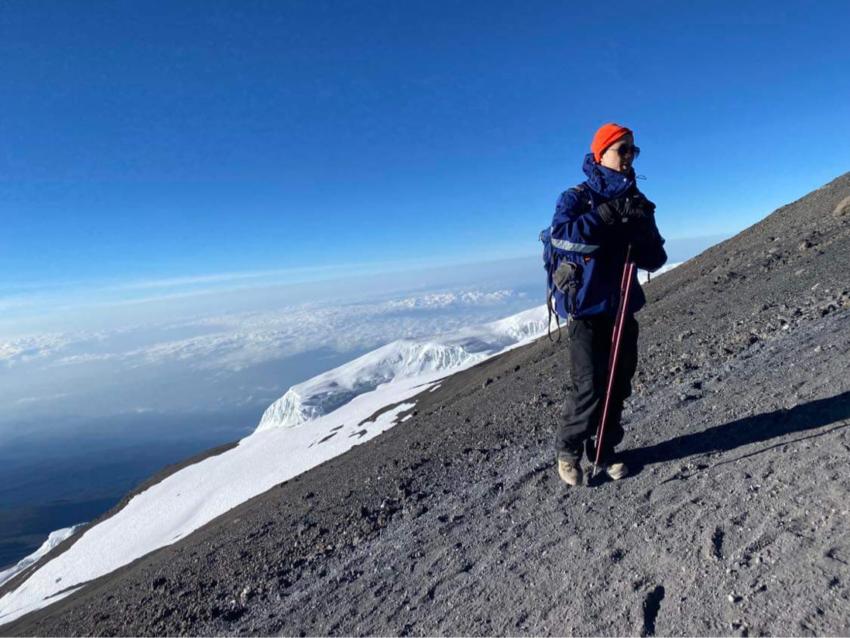Ascending Mount Kilimanjaro, did you know climbers experience all four seasons in a single trek? From the tropical, bustling rainforests at the base to the frigid arctic temperatures near the summit, Kilimanjaro presents a unique weather adventure. The diverse weather conditions make it imperative to be well-prepared and adaptable.
One notable fact is that temperatures can drop to -7°C or lower at night, even in the dry season. Historically, the rainiest months are March and April, while January and February tend to be warmer and relatively dry, accounting for 40% of the annual summit successes. Staying informed about these patterns and dressing in layers ensures safety and comfort during the climb.

Weather Tips: What to Expect on Kilimanjaro
Climbing Kilimanjaro involves experiencing various climate zones. Not only will you start in lush, humid forests, but you’ll also trek through desert-like moorlands. Near the summit, temperatures can plummet drastically, making it crucial to pack wisely. The diverse weather patterns mean that a sunny morning can quickly turn into a chilly afternoon. So, being prepared for sudden changes is essential for a successful climb.
Rainfall varies throughout the year. The long rains typically occur from March to May, while the shorter rains are in November. These months tend to be less preferred by climbers due to slippery paths and increased cloud cover. However, the landscape is incredibly lush and beautiful during these times. If you decide to climb during the rainy season, high-quality waterproof gear is a must.
Despite being near the equator, the mountain’s elevation causes temperatures to drop significantly. At night, especially near the summit, temperatures can fall below freezing. This means climbers need to dress in layers, allowing them to adjust their clothing as needed. During the day, the sun can be intense, so sunscreen and a hat are indispensable. A combination of warm and light clothing is key to enjoying the trek.
Unexpected weather conditions can pose hazards. Snowfall and strong winds are not uncommon at higher altitudes. Climbers should be aware of the symptoms of altitude sickness, which can be exacerbated by the cold. Guided tours often provide the best insights into current weather conditions. Always consult local guides for the most accurate weather forecasts and safety precautions before embarking on your journey.
What is the Weather on Mount Kilimanjaro? (Be Prepared for Anything!)
Seasonal weather fluctuations on Kilimanjaro
Kilimanjaro experiences dramatic weather changes throughout the year. Each season brings unique conditions that impact trekkers. March to May is the long rainy season, leading to muddy trails and reduced visibility. These months also provide the lushest landscapes. If you enjoy vibrant greens, this can be an appealing time for hiking.
The drier season lasts from June to October, a popular time for climbing. During these months, the sky is often clear, offering spectacular views. The paths are less slippery, which can make the trek safer. But don’t forget, nights can be chilly despite the daytime warmth. Proper gear is essential to stay comfortable.
November brings short rains, usually lighter than the long rainy season. Quick showers in the afternoon are common, while mornings can still be sunny. This season doesn’t deter all adventurers, but it requires being prepared for rain. Bring a durable raincoat and waterproof shoes. The mountain’s unpredictable weather means being ready for anything.
December to February is known for its warmer temperatures, with less rain compared to other months. This period can still have unexpected weather, like sudden rain showers. Even under the equatorial sun, temperatures drop as you ascend. Carrying both sun protection and thermal layers is crucial. The mountain keeps you on your toes, reminding you why preparation is key for a successful expedition.
Best time to Climb Kilimanjaro: Weather-wise
Choosing the right time to climb Kilimanjaro involves understanding the mountain’s weather patterns. The periods from January to March and from June to October are generally considered the best. During these months, climbers enjoy dry paths and clearer skies. The reduced rainfall makes navigation easier and enhances visibility. Many trekkers aim for these windows for a more pleasant experience.
Within these optimal months, each has its own allure. January and February boast slightly warmer temperatures. March marks the transition to wetter conditions, which can offer fewer crowds. In contrast, June through October benefits from the dry season, making it perfect for those who prefer more predictable conditions. Regardless of when you decide to climb, each season offers unique scenic wonders.
Climbers should also be mindful of weather variations during these months. While temperatures are more manageable, they can still fluctuate significantly. Cold nights near the summit require preparation with warm clothing and gear. The clear skies during the day offer unhindered views of the breathtaking scenery. It’s essential to pack for both warm days and chilling nights.
Outside these windows, climbing can be more challenging due to rainier weather. The wetter seasons see fewer tourists, which can appeal to those seeking solitude. However, trekkers need to be equipped for wet conditions. Trails can be muddier and visibility reduced, so careful planning is crucial. Choosing the best time to climb can make all the difference in your overall experience.
What to Pack for Different Weather Conditions on Kilimanjaro
Packing for Kilimanjaro requires careful consideration of the weather. Since climbers experience five different climate zones, versatility is key. Start with a reliable layering system, including base, middle, and outer layers. Thermal base layers help retain body heat, while fleece jackets offer necessary insulation. Make sure your outer layer is waterproof to protect against sudden rain showers.
Footwear is among the most crucial items. Proper hiking boots are essential for providing support on uneven terrain. Waterproof boots are a must, especially during rainy seasons. Pack several pairs of moisture-wicking socks to keep your feet dry and comfortable. Gaiters can also help keep mud and debris out of your boots.
Don’t overlook the importance of accessories. Sunglasses, a hat, and gloves are necessary for different weather conditions. Sun protection is crucial because the sun’s rays are strong at high altitudes. Gloves and a warm hat are needed for the colder altitudes near the summit. Balaclavas are also useful for protecting your face from the wind.
Your packing list should include essential gear for safety and comfort. A good-quality sleeping bag rated for below-freezing temperatures is vital. Trekking poles can help with stability and reducing strain on your legs. A headlamp with extra batteries is also crucial, especially for early morning summit pushes. Hydration packs or water bottles are necessary for staying hydrated.
Consider packing a few specialty items based on the season. During wet months, additional rain gear like waterproof pants and a rain cover for your backpack is recommended. In drier months, extra sunscreen and lip balm with UV protection are necessary. Always pack high-energy snacks to keep your energy levels up. Preparing for various weather scenarios ensures a safer and more enjoyable trek.
Weather Conditions at Different Altitudes of Kilimanjaro
Mount Kilimanjaro’s unique weather becomes evident as you ascend through its various altitudes. At the base, in the lush rainforest, the climate is typically warm and humid. Rainfall is frequent, so waterproof clothing is a necessity. The dense vegetation thrives under these conditions, offering hikers a verdant canopy. It’s a stark contrast to what awaits higher up.
Moving upwards, the moorland zone presents cooler temperatures. The landscape changes dramatically, with fewer trees and more shrubs. Weather conditions are less predictable, with a mix of sun and rain. Daytime temperatures can still be warm, but nights become cooler. It’s important to continue layering clothing to stay comfortable.
Further up is the alpine desert, where conditions shift notably. Temperatures drop significantly, and the air becomes drier. Strong winds are common, creating a need for windproof clothing. Sunshine can be intense during the day, so sun protection remains crucial. The barren landscape marks a distinct shift from lower elevations.
At the summit, the arctic zone presents the most challenging conditions. Freezing temperatures are common, especially at night. Snow and ice may cover the paths, adding to the difficulty. Staying warm is essential, so thermal gear and insulated clothing are mandatory. Despite the cold, the breathtaking views from the top are a rewarding finale to the climb.
Tracking the temperature and weather changes helps in preparation. A summary can be depicted in a simple table for easy understanding:
| Altitude Zone | Typical Conditions |
|---|---|
| Rainforest | Warm, humid, frequent rainfall |
| Moorland | Cooler, mixed sun and rain |
| Alpine Desert | Cold, dry, strong winds |
| Arctic Zone | Freezing, icy, snow-covered |
Potential weather-related Hazards on Kilimanjaro
When climbing Kilimanjaro, weather-related hazards pose significant challenges. One of the main dangers is altitude sickness, often triggered by rapid changes in altitude. Symptoms can range from headaches and nausea to more severe effects that require immediate attention. It’s crucial to ascend slowly, allowing the body to acclimatize. Climbers should always be prepared to descend if symptoms worsen.
Weather on the mountain can change unexpectedly, leading to other risks. Sudden storms can bring heavy rain, making trails slippery. This increases the chances of slips and falls, which can lead to injuries. During these times, having good hiking boots with a solid grip is invaluable. Using trekking poles can also provide additional stability.
Cold temperatures at higher altitudes present their own hazards. Frostbite and hypothermia are real threats on particularly cold days. Adequate preparation with thermal clothing and insulated gear is essential. Climbers should ensure they have multiple layers to protect against the cold. Staying dry is also vital to avoiding these conditions.
Strong winds can occur, especially near the summit. These winds can chill the body rapidly and make progress difficult. Ensuring your gear, such as jackets and tents, is wind-resistant is wise. Keeping an eye on the weather forecast can help avoid some windy conditions. If the winds are too strong, it may be safer to postpone the trek.
Visibility can be a concern in fog or heavy cloud cover. Poor visibility can lead to navigation issues, causing trekkers to stray off the path. Having a knowledgeable guide or using GPS can assist in these situations. Always keeping a map and compass handy can provide extra security. Preparation and awareness are key to handling potential weather hazards effectively.
Key Takeaways
- Kilimanjaro’s climate zones offer varied weather experiences for climbers.
- Packing layers ensures comfort across different altitude temperatures.
- Expect sudden rain, especially in rainforest areas during wet months.
- Sun protection is crucial due to intense rays at higher altitudes.
- Acclimatization helps prevent altitude sickness on the mountain.




